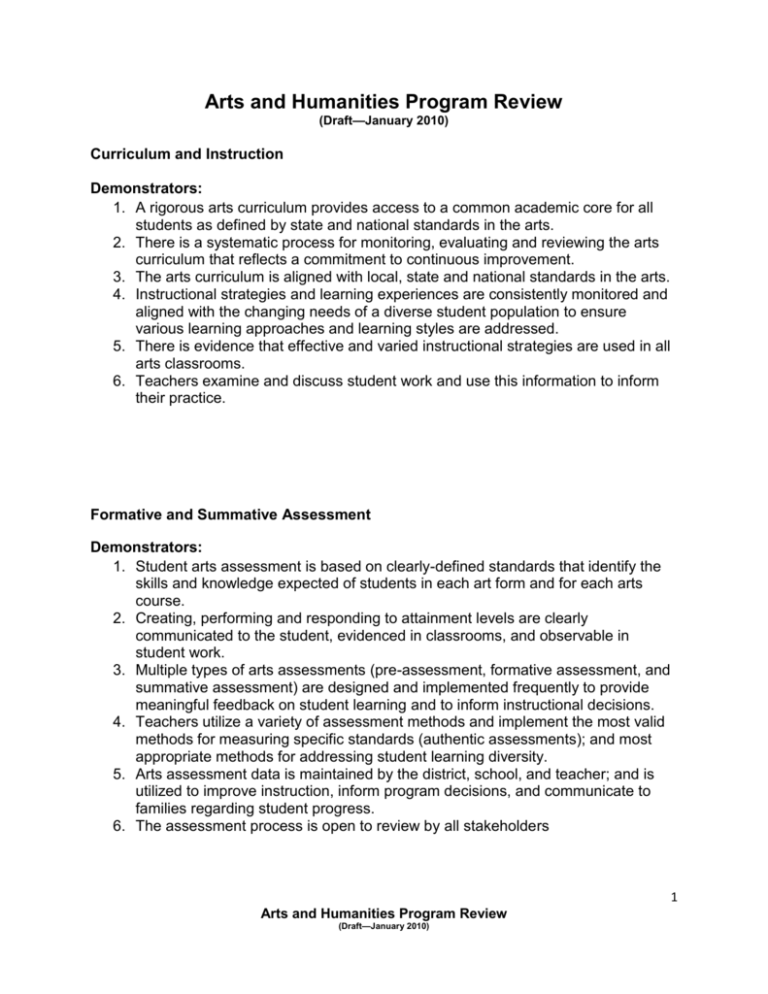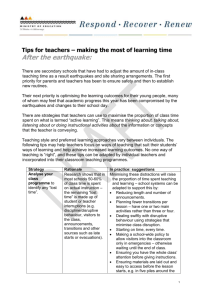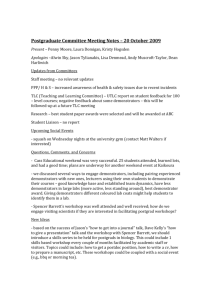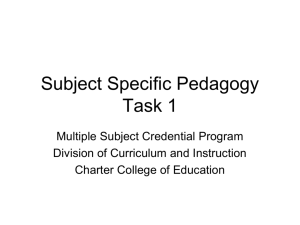Arts/Hum Demonstrators - Kenton County Schools
advertisement

Arts and Humanities Program Review (Draft—January 2010) Curriculum and Instruction Demonstrators: 1. A rigorous arts curriculum provides access to a common academic core for all students as defined by state and national standards in the arts. 2. There is a systematic process for monitoring, evaluating and reviewing the arts curriculum that reflects a commitment to continuous improvement. 3. The arts curriculum is aligned with local, state and national standards in the arts. 4. Instructional strategies and learning experiences are consistently monitored and aligned with the changing needs of a diverse student population to ensure various learning approaches and learning styles are addressed. 5. There is evidence that effective and varied instructional strategies are used in all arts classrooms. 6. Teachers examine and discuss student work and use this information to inform their practice. Formative and Summative Assessment Demonstrators: 1. Student arts assessment is based on clearly-defined standards that identify the skills and knowledge expected of students in each art form and for each arts course. 2. Creating, performing and responding to attainment levels are clearly communicated to the student, evidenced in classrooms, and observable in student work. 3. Multiple types of arts assessments (pre-assessment, formative assessment, and summative assessment) are designed and implemented frequently to provide meaningful feedback on student learning and to inform instructional decisions. 4. Teachers utilize a variety of assessment methods and implement the most valid methods for measuring specific standards (authentic assessments); and most appropriate methods for addressing student learning diversity. 5. Arts assessment data is maintained by the district, school, and teacher; and is utilized to improve instruction, inform program decisions, and communicate to families regarding student progress. 6. The assessment process is open to review by all stakeholders 1 Arts and Humanities Program Review (Draft—January 2010) Professional Development and Support Services Demonstrators: 1. There is support for on-going professional development that is relevant to the level of all staff members’ understanding in the arts in relation to creating, performing and responding. 2. School has an intentional plan for building instructional growth in the arts through on-going professional development. 3. Staff professional development in the arts directly connects arts goals in the Comprehensive School Improvement Plan (as needed based on needs in the review) for student performance, and individual professional growth of staff which sets priorities for the school and district professional development activities in the arts. 4. On-going professional development in analysis of student work enables teachers to determine and improve the quality of student achievement in creating, performing and responding in the arts. 5. Professional development in dance, drama, music and visual arts supports improved instructional practices, innovative ways of teaching, use of arts-specific technology, and effectiveness in the application of skills, processes and content in the visual and performing arts. 6. Professional development in understanding the arts to highlight ways teachers can seize opportunities for integrating 21st century skills, tools and teaching strategies into their classroom practice. Administrative/Leadership Support and Monitoring Demonstrators: 1. Leadership has developed and sustained a shared vision of a quality arts education. 2. The instructional and non-instructional staff are allocated and organized based on the instructional needs of all students in the arts. 3. School leadership and staff make efficient use of instructional time to maximize student learning in the arts. 4. The school maintains a focus on maximizing use of all available resources to support high student and staff performance in the arts 5. School leadership supports the arts as part of the core curriculum at every level. 2 Arts and Humanities Program Review (Draft—January 2010)










